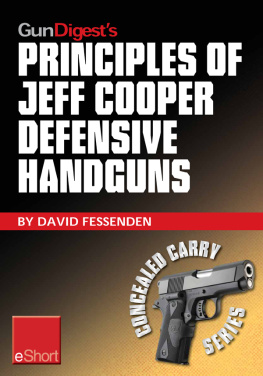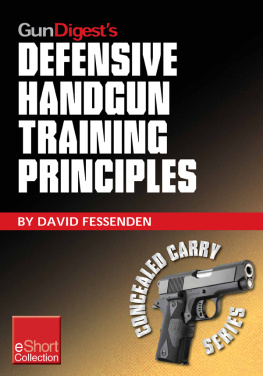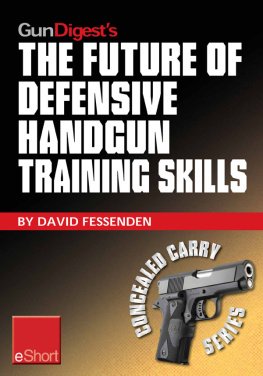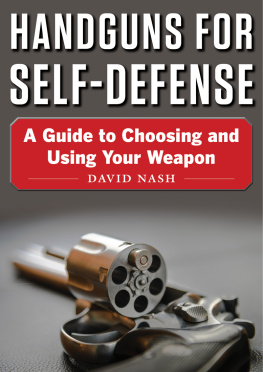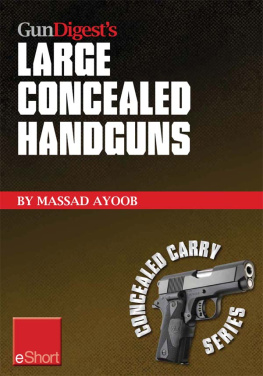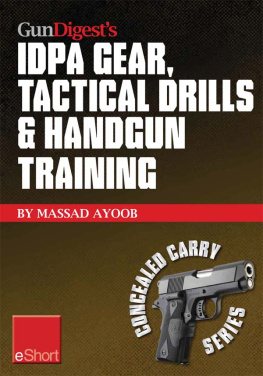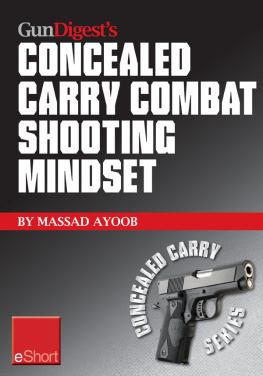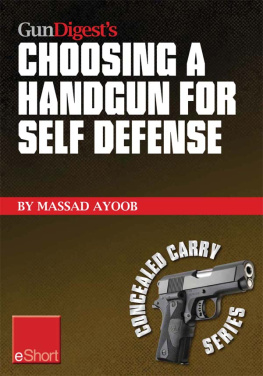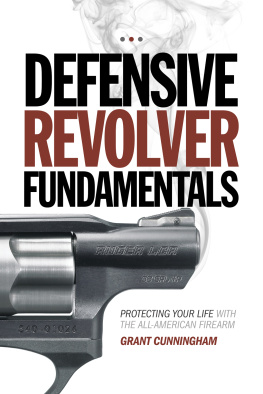David Fessenden - Gun Digests Principles of Jeff Cooper Defensive Handguns eShort
Here you can read online David Fessenden - Gun Digests Principles of Jeff Cooper Defensive Handguns eShort full text of the book (entire story) in english for free. Download pdf and epub, get meaning, cover and reviews about this ebook. year: 2012, publisher: F+W Media, genre: Romance novel. Description of the work, (preface) as well as reviews are available. Best literature library LitArk.com created for fans of good reading and offers a wide selection of genres:
Romance novel
Science fiction
Adventure
Detective
Science
History
Home and family
Prose
Art
Politics
Computer
Non-fiction
Religion
Business
Children
Humor
Choose a favorite category and find really read worthwhile books. Enjoy immersion in the world of imagination, feel the emotions of the characters or learn something new for yourself, make an fascinating discovery.
- Book:Gun Digests Principles of Jeff Cooper Defensive Handguns eShort
- Author:
- Publisher:F+W Media
- Genre:
- Year:2012
- Rating:4 / 5
- Favourites:Add to favourites
- Your mark:
- 80
- 1
- 2
- 3
- 4
- 5
Gun Digests Principles of Jeff Cooper Defensive Handguns eShort: summary, description and annotation
We offer to read an annotation, description, summary or preface (depends on what the author of the book "Gun Digests Principles of Jeff Cooper Defensive Handguns eShort" wrote himself). If you haven't found the necessary information about the book — write in the comments, we will try to find it.
In this excerpt from Defensive Handgun Skills, David Fessenden teaches Jeff Coopers universal rules of firearm safety, color code of mental awareness, modern techniques for the defensive pistol and self-defense principles.
Gun Digests Principles of Jeff Cooper Defensive Handguns eShort — read online for free the complete book (whole text) full work
Below is the text of the book, divided by pages. System saving the place of the last page read, allows you to conveniently read the book "Gun Digests Principles of Jeff Cooper Defensive Handguns eShort" online for free, without having to search again every time where you left off. Put a bookmark, and you can go to the page where you finished reading at any time.
Font size:
Interval:
Bookmark:


We have examined and established the history of and the definition of the art of defensive guncraft. Now, lets explore in more detail the principles or influences that help us to reinforce and fortify the tenets of this art. They bolster and energize our beliefs and guide us on our journey toward a mastery of the handgun. They will aid us in understanding and reaching our goal of attaining the mindset we call the Comfort of Skill at Arms. (I will discuss the Comfort of Skill at Arms in detail later.) Indeed, you must have a total mastery of these factors before you learn all the firearms skills necessary to competently and safely handle your firearm. View them as the foundation upon which you construct your skill level, layer by layer up this ladder of firearms proficiency. These principles are as follows:
The Four Universal Rules of Firearms Safety
The Color Code of Mental Awareness
The Modem Technique of the Pistol
Coopers Principles of Personal Defense
We have already discussed the Four Universal Rules of Firearms Safety. Lets examine the remaining principles in detail, along with other experts perspectives.
This is another gem from the mind of Jeff Cooper. Here, Cooper states that there are several levels of awareness that a person must be in at all times during the day. They are essential to giving oneself a chance to spot trouble that may be coming his or her way and may also allow time to survive the threat. Cooper did not create these principles but refined and compiled them from his days in the Marine Corps, adapting them for civilian use. The conditions are as follows:
This is the lowest form of awareness and consists of a total lack thereof. In this condition, you could be run over by a steamroller or about to be hit over the head with a baseball bat and not even see it coming.
This is a condition of relaxed awareness and is the condition that all people must be in at all times. In condition yellow, you are observing and alert to all that is going on about you. You are making mental notes on all these activities. You will not betray to these folks that you are cognizant of their activities, so as to not telegraph to them your alert condition.
In Condition Yellow, for example, you might observe an individual wearing a heavy sweatshirt in 90 weather. He appears overdressed and definitely out of place compared to everyone else in the immediate area. This may trigger some level of concern in you. What is he hiding under that sweatshirt? Your Condition Yellow has served you well thus far.
To continue the example, you now realize or sense that the person in the sweatshirt is following you to your car and, from his body language, you can tell that he is up to no good. His hand is moving to his waistband. Sensing an imminent threat, you are in Condition Orange.
You now see the threat and recognize the need to take immediate action to insure your safety. His hand is now on the handle of a knife or revolver frame that he is withdrawing from under that sweatshirt. You have confirmed the threat and are in Condition Red.
In Condition Black, you take defensive action. Your training kicks in and you take steps to ensure that you are protected. You may flee the area or stand and defend yourself with anything from pepper spray to lethal force.
Follow me on this: I believe thoroughly in and teach the Color Code of Mental Awareness but find that the last two levels, Red and Black, are not really about awareness in the strictest sense. Rather they are levels of action, in that at that point in the process, you need to act somehow. Your survival mode training kicks in and you are no longer simply observant. In order to survive the threat, you must act in some manner.
Some may argue that I am splitting hairs here, but you must understand the complexity of the awareness picture and the point at which things become actionable as the scenario unfolds. A purely robotic approach to these important factors may result in someone dead or hurt. I am totally comfortable with teaching all five conditions as a legitimate part of Coopers Code.

Eric Lawrence, in his instructional shooters book The Operators Tactical Pistol Shooting Manual,offers these three tenents of awareness that can be important to whether a potential victim will survive a potentially violent attack:
1. Perceive a threat is there. Always watch for strange behavior.
2. Recognize the threat and prepare your action plan.
3. Acquire the threat and immediately act on that plan. It usually becomes a case of fight or flight!
There is some merit to the principles listed below, but I find most of them a bit frivolous. Several of them are rather obvious to anyone who is concerned in any way with his survival in any situation. One exception here might be the combat mindset. Without combat mindset, survival in the face of any violent threat is a grim prospect at best. It is the cornerstone for all those concerned with their survival.
Stephen P. Wenger, in his book Defensive Use of Firearms, devotes space for his and Massad Ayoobs versions of the principles of survival. Much is made about each ones differences of opinion and who has more principles. It seems to be a war of semantics in the simplest sense. Here is what each is advocating:
Ayoob
1. Mental Awareness and Preparedness
2. Tactics
3. Skill
4. Choice of Equipment
Wenger
1. Mental Awareness
2. Mental Preparedness
3. Tactics
4. Skill
5. Choice of gear
So Ayoob has four principles and Wenger espouses five principles. Okay, but they are both stating the exact same thing. It really doesnt matter which of these lists you adopt. I do not have any heartburn with either of these lists, nor with the reason for their existence. It just appears to be a case of my list is bigger than yours!
Just for the record, here is my list:
1. Combat mindset
2. Training
3. Awareness (Color Code)
4. Choice of Gear
As stated before, I am keeping it simple by combining the states of mental awareness and preparedness into one: combat mindset. This mental awareness-preparedness stuff is fine, but its redundant. One begets the other. Combat mindset is all-inclusive and covers any and all awareness and preparedness issues.

The Modern Technique of the Pistol was not a published book or paper by Col. Cooper, but rather a theme and a regimen that was instituted at Gunsite. Remember, Cooper formulated his Modern Technique as a direct result of his Big Bear, California, shooting events and the changes that evolved from the adoption of the combat techniques that he and his friends then used to compete with during these events. Cooper simply applied his Modern Technique
Font size:
Interval:
Bookmark:
Similar books «Gun Digests Principles of Jeff Cooper Defensive Handguns eShort»
Look at similar books to Gun Digests Principles of Jeff Cooper Defensive Handguns eShort. We have selected literature similar in name and meaning in the hope of providing readers with more options to find new, interesting, not yet read works.
Discussion, reviews of the book Gun Digests Principles of Jeff Cooper Defensive Handguns eShort and just readers' own opinions. Leave your comments, write what you think about the work, its meaning or the main characters. Specify what exactly you liked and what you didn't like, and why you think so.

